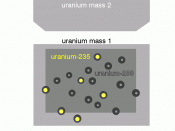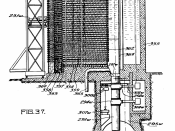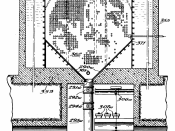In the 1930's scientists were finding very intriguing things about the use of the atom's power and atomic fission. Fission is the process by which the nucleus of a heavy element absorbs a neutron, which forces it to split into two nearly equal halves. Scientists discovered that when an atom split, the sum of all the parts it split into did not, in fact, add up to the original mass (weight) of the atom. In fact, well over 99.9% of the mass was accounted for, but some small amount appeared to have vanished. According to Einstein, matter and energy are related. That is, the chair on which you are sitting could turn completely into energy if circumstances were right, and some of the sun's massive energy output could be converted into matter if conditions were right. In fact, if the chair in which you were sitting were converted entirely into energy, it would be sufficient to destroy the entire solar system--so great is the amount of energy given off when matter undergoes this transformation.
Physicists realized that if they could make enough atoms fission they could create huge volumes of energy. Unfortunately, it is far more simple to make one atom of Uranium split than it is to make ten pound of Uranium do the same. What was needed was a self-sustaining nuclear chain reaction--a process by which one or a few forced nuclear fissions spawned enough other fissions to keep a reaction going until all the nuclear material was eliminated.
In the late 1930's, Leo Szilard suddenly realized that a chain reaction might in fact be possible--to the scorn of many of his colleagues. He immediately came to the United States and began requesting research money. Unfortunately, everyone laughed him down. At the time, people were far more...


